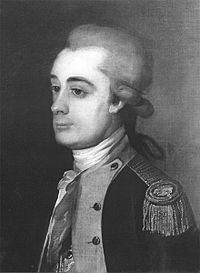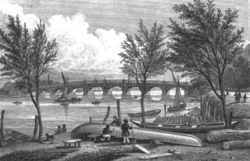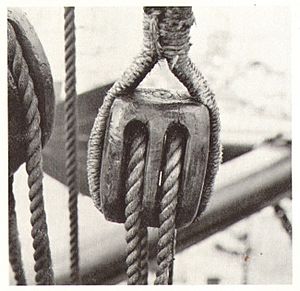Samuel Bentham facts for kids
Quick facts for kids
Samuel Bentham
|
|
|---|---|
 |
|
| Born | 11 January 1757 England
|
| Died | 31 May 1831 (aged 74) London, England
|
| Spouse(s) | Mary Sophia Fordyce |
| Children | George, Clara, Sarah, Mary Louisa |
| Relatives | Jeremy Bentham (brother) |
Samuel Bentham was a clever English engineer and inventor. He was born on January 11, 1757, and passed away on May 31, 1831. Samuel made many new things, especially for ships and the navy. He was the only brother of the famous thinker, Jeremy Bentham, and they were very close.
Contents
Early Life and Training
Samuel Bentham was one of two children who survived from his family. His father was a lawyer. His older brother, Jeremy Bentham, became a well-known philosopher. Sadly, five other brothers and sisters died when they were babies. Their mother also passed away in 1766.
When Samuel was 14, he started training to be a shipbuilder. He worked at Woolwich Dockyard and Chatham Dockyard. After seven years, he finished his training at the Naval Academy in Portsmouth.
Samuel's Career and Inventions
Working in Russia
In 1780, Samuel moved to Russia. He worked for Prince Potemkin, who wanted to bring new ideas and skills to Russia. Samuel was first hired to build ships. Soon, he found other ways to use his engineering talents.
He built machines for factories and experimented with making steel. Samuel also designed many new inventions. These included a boat that could travel on land and water. He also made a special barge for Catherine the Great, the empress of Russia.
Samuel was honored for his role in a big victory against the Turks. He even led a group of 1,000 soldiers in Siberia. Eventually, he was in charge of all of Prince Potemkin's factories. It was here that he thought of a new way to watch over many workers.
He came up with the idea of "central inspection." This led him to design the Panopticon building. This building allowed one person to watch many others without them knowing. His brother Jeremy later made this idea very famous.
In 1782, Bentham traveled to China through Siberia. He visited cities like Kyakhta and Nerchinsk. There, he studied Chinese ship designs, especially the junks. When he returned to Europe, he pushed for ships to have watertight compartments. He said he got this idea from the large Chinese ships he saw.
Samuel came back to England in 1791. For a few years, he worked with his brother Jeremy. They tried to get the Panopticon idea built. Samuel also designed machines for it. During this time, he met Mary Sophia Fordyce. She was the daughter of a friend of Jeremy's. Samuel and Mary got married in October 1796.
In 1795, the British Navy asked Samuel to design six new sailing ships. These ships would have special walls inside to make them stronger. These walls would also help keep the ship from sinking, just like Chinese ships. These ships were built and had other new features. For example, their masts and spars could be swapped out easily. This made them easier to fix at sea.
In March 1796, Samuel Bentham got an important job. He became the Inspector General of Naval Works. His job was to keep the Royal dockyards in good shape and make them better. This job meant he had to travel a lot.
He suggested many improvements. These included using steam power in the dockyards. He also wanted to use machines for many building tasks. However, the people in charge at the Navy Board did not like change. Many of his ideas were not used.
Bentham helped to change how wooden pulley blocks were made. These blocks were used in ships' rigging. He designed machines to make them faster and better. His 1793 patent for woodworking machines was very important. Fifty years later, judges called it a "perfect treatise" on the subject.
Marc Isambard Brunel also designed similar machines. He showed them to Bentham, who saw that Brunel's designs were even better. Henry Maudslay, who built these machines, became a famous machine builder. The Portsmouth Block Mills showed how mass production could work in Britain.
Another Trip to Russia
In 1805, Bentham went back to Russia for the British government. He stayed there for two years with his family. He even rented a whole ship for his family, servants, and friends. Samuel's mission for the British government faced many problems. He returned home in 1807 without reaching his goals.
While in Russia, he oversaw the building of a Panopticon School of Arts. This school was on the banks of the Okhta River in St. Petersburg. He had first thought of this design in 1786. The building was later destroyed by fire. We only know about it from drawings.
Designing Vauxhall Bridge

Bentham also designed a bridge for the Butterly company. It was a nine-arch bridge made completely of cast-iron. This bridge was meant for Vauxhall Bridge in London. It would have been the first iron bridge over the Thames River.
Cast iron was chosen because it was "cheaper than masonry." Some ideas for the bridge came from Bentham's time in China. There, many such arched iron bridges already existed. However, people had doubts about the design's quality. So, a different design was chosen. A bridge with "cast iron arches on masonry piers" was built by James Walker. It was finished in May 1813.
Life in France
When Bentham returned to England, he found his job as Inspector General was gone. He even thought he had been sent to Russia just so his job could be removed. In 1814, he and his family moved to the south of France. They lived there until 1826.
The Bentham family traveled a lot in France. In 1820, they settled at the Château de Restinclières. This was in the Languedoc-Roussillon area. Their new house was large with big grounds. Bentham planned to farm the land for money. His son, George, managed most of the farm work.
Bentham brought new farm machines to France. He also set up a complex watering system for his land. They did well for a while. But they eventually returned to England in 1826. One reason was a possible lawsuit from nearby farmers. They said Bentham's watering system was taking their water supply.
In England, Bentham spent most of his time writing about ships. He also did experiments on how ship hulls should be shaped. His son, George Bentham, born in 1800, became a famous botanist.


